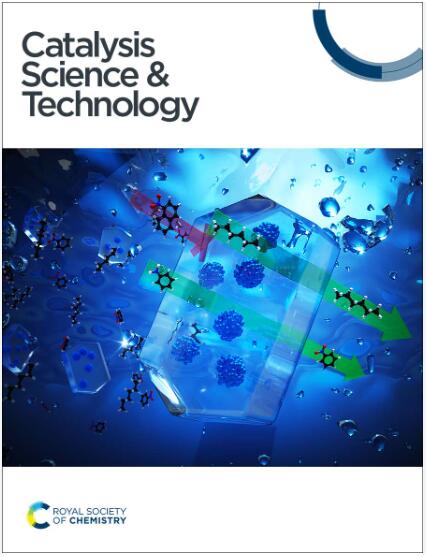Oxygen vacancy-engineered In2O3@carbon catalysts from steam-pyrolyzed MOFs for photothermal CO2 hydrogenation†
IF 4.2
3区 化学
Q2 CHEMISTRY, PHYSICAL
引用次数: 0
Abstract
Photothermal CO2 hydrogenation has attracted considerable attention as a promising approach to utilize carbon dioxide through the efficient conversion of solar energy into chemicals and fuels. In this study, we report a novel approach to improve the catalytic performance of indium oxide-based catalysts for the photothermal reverse water-gas shift (RWGS) reaction. Catalysts derived from the steam pyrolysis of the metal–organic framework MIL(In)-68 display a high density of oxygen vacancies and defect sites on the In2O3 surface. These features significantly enhance CO2 adsorption and H2 dissociation ability while maintaining the porosity of the material and enhancing its photothermal properties. Among the catalysts investigated, the Rb-promoted catalyst exhibited superior activity, achieving CO production rates of 53 mmol gIn2O3−1 h−1 with 100% selectivity without any external heating. Comprehensive characterization, including XPS and Raman spectroscopy, confirmed that steam-pyrolysis leads to extensive defective site formation, resulting in improved catalytic performance. These results highlight the potential of steam-pyrolyzed MOF materials as efficient and selective catalysts for photothermal CO2 hydrogenation, offering a sustainable route to valuable chemical production.

氧空位工程In2O3@carbon蒸汽热解mof光热CO2加氢催化剂†
光热CO2加氢作为一种很有前途的利用二氧化碳的方法,通过将太阳能有效地转化为化学品和燃料,引起了人们的广泛关注。在这项研究中,我们报道了一种新的方法来提高氧化铟基催化剂在光热逆水气转换(RWGS)反应中的催化性能。金属有机骨架MIL(In)-68的水蒸气热解催化剂在In2O3表面表现出高密度的氧空位和缺陷。这些特性显著增强了CO2吸附和H2解离能力,同时保持了材料的孔隙度,增强了材料的光热性能。在所研究的催化剂中,rb促进的催化剂表现出优异的活性,在没有任何外部加热的情况下,其CO产率为53 mmol gIn2O3−1 h−1,选择性为100%。综合表征,包括XPS和拉曼光谱,证实了蒸汽热解导致大量缺陷位点的形成,从而提高了催化性能。这些结果突出了蒸汽热解MOF材料作为光热CO2加氢的高效和选择性催化剂的潜力,为有价值的化学生产提供了一条可持续的途径。
本文章由计算机程序翻译,如有差异,请以英文原文为准。
求助全文
约1分钟内获得全文
求助全文
来源期刊

Catalysis Science & Technology
CHEMISTRY, PHYSICAL-
CiteScore
8.70
自引率
6.00%
发文量
587
审稿时长
1.5 months
期刊介绍:
A multidisciplinary journal focusing on cutting edge research across all fundamental science and technological aspects of catalysis.
Editor-in-chief: Bert Weckhuysen
Impact factor: 5.0
Time to first decision (peer reviewed only): 31 days
 求助内容:
求助内容: 应助结果提醒方式:
应助结果提醒方式:


